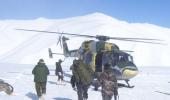All of India welcomes the Light Combat Helicopter into the Armed Forces arsenal and wishes it a safe tenure and happy shooting.
May it rule the skies and ensure that the enemies are given a fitting reply when the need arises.
IAF Veteran Air Commodore Nitin Sathe traces the Light Combat Helicopter's historic journey from conception to induction into the Indian Air Force today, October 3, 2022.
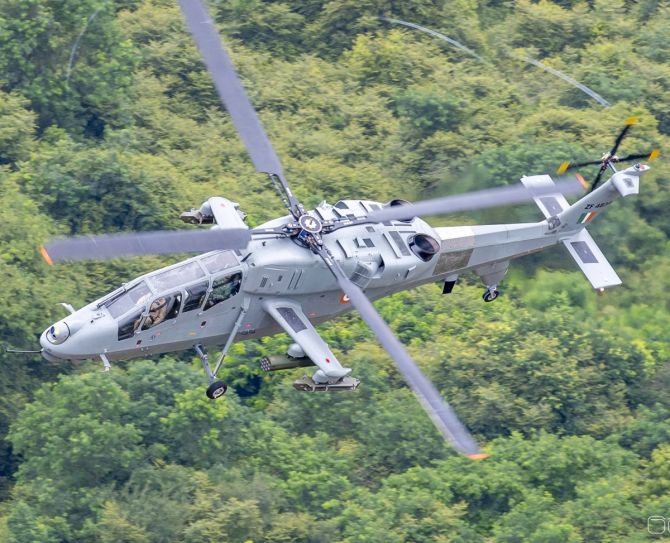
I tell Indian Air Force Veteran Group Captain Hari 'Harry' Nair, one of the lead flying members on the Light Combat Helicopter, to tell me something more about the flying characteristics and his experiences of flying India's new combat helicopter.
He asks me to get in touch with Wing Commander Subhash P John, a dear friend with whom I had the privilege of flying with in my Mi-35 days.
John was entrusted to carry out the weapon integration on the aircraft.
At Hyderabad during the ceremonies to commemorate 60 years of helicopters in India recently, John flew the aircraft in front of us many serving and retired helicopter pilots and left us spell bound.
We saw how the helicopter could be thrown around like a fighter and with this agility, we were confident that it could outmanoeuvre the best in the game.

I tell Harry to tell me something more about the LCH's flying characteristics before I get in touch with John.
"She behaves like a bull, but handles like a baby," says Harry.
"The LCH charges though the vagaries of weather at all altitudes like a composed bull," says Harry elaborating his point.
"The hinge-less elastomeric rotors made of carbon fibre are crafted for max manoeuvrability and good handling. The shape of the aircraft makes it accelerate quickly to top speeds of 330 plus kmph. The helicopter can be easily operated in the higher reaches of our Himalayas with its max operating height being more than 21,000 feet."
The aptly named 'Shakti' engines fitted on the helicopter are a collaborative effort of the HAL and Safran, the French giant.
The hot zone (compressor, combustion chamber etc form the hot zone) have been imported from the foreign vendor while the cold zone has been indigenously designed by HAL.
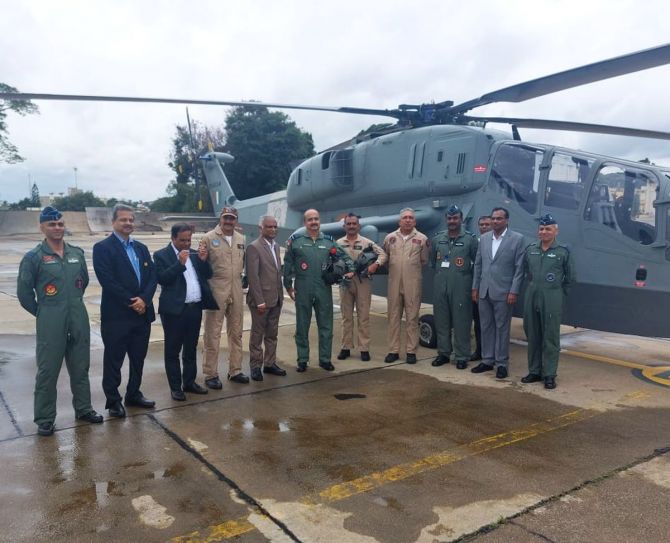
Harry tells me that the development of the air intake of the engines was a major engineering feat.
"Our designers worked hard for months and made some innovative changes to the air intake of the engines which made sure that the loss of power at altitudes was minimal."
"I remember during this phase, Mr Chalvade, the passionate designer and aerodynamist. would ask me to come to the hangar where the LCH was parked.
"We would sit atop the maintenance stand along with a few of his design team and stare hard at the engine intake.
He would discuss the issue threadbare on-the-spot, make sketches, which his team would further analyse and refine through computer modelling.
"A darkened area of the hangar was called the 'black box' where we also tested the night operations module. Speaking of the black box, I am reminded of the time when we were stuck with an issue of reflections from the instruments inside the cockpit which were detrimental to flying with Night Vision Goggles (NVGs). This was finally resolved by spending several man-hours in that black box.
"Another peculiar problem we faced was when we had to position the pitot tube. The pitot tube is used to measure the speed of the aircraft and it has to be fixed at a place where there is least disturbed airflow.
"What we found out was that when the heater of the pitot tube was turned on (it is done to prevent ice accretion and blockage during flying), the infra-red camera of the helicopter picked it as a heat source and it effectively jammed the sensor.
"To fit the tubes in the correct place took months of iterative testing till we found the correct place where accurate reading of the airspeed was possible."

THE JOURNEY FROM DRAWING BOARD TO INDUCTION
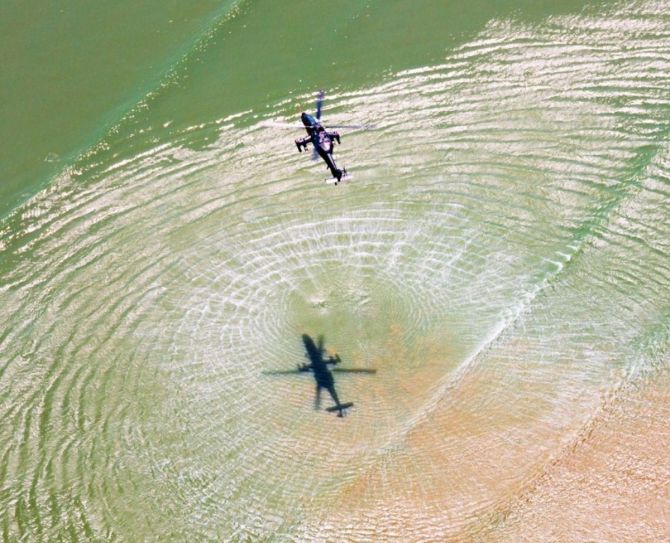
I got speaking with Wing Commander John, who has been involved in the project and responsible for the avionics and armament systems integration.
Johnny baba, as we called him when we flew together, is a man of few words and I had to pester him to tell me a few stories.
He began with how he was instrumental in getting the aircraft its name.
"For some time, the helicopter was named 'Janamejaya', after the Kuru king of Vedic times. In one of the air shows, we were to fly a formation with Janamejaya as call sign. I was doing the briefing in which a discussion ensued about the name. It was opined that the name did not gel well with the other call signs and was too long and difficult to call out in the air.
"I had about five seconds to come up with a new name and all I could think of in that moment was 'Dhanush', to go with the Dhruv (ALH) and Rudra (ALH Weapon System Integrated). This name stuck and the LCH has been referred to as 'Dhanush' till date. It now is left to our armed forces to choose another name for it when inducted."
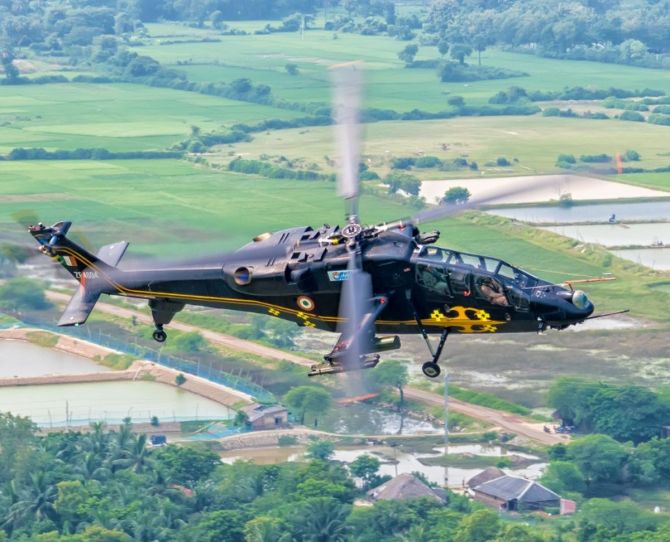
"We were deployed in Ladakh in August and September of 2020 when the situation there was extremely volatile.
"Within two days of being told to deploy, we moved to Leh and were ready for operations within a day of landing.
'We carried out missions to DBO (Daulat Beg Oldie), Lukung, very close to Demchok etc.
"Typically, a mission would comprise of getting airborne early morning, land at forward helipads flying along the border, refuel and get back to Leh by sunset.
"There was no ground crew support and both the machines performed exceptionally well without any technical hitches throughout the operations.
"We flew the then Vice Chief of Air Staff and other senior IAF officers in the cockpit enabling them to recce the complete Area of Responsibility (AOR). It was the middle of summer and the temperatures were touching 35 degrees at Leh."
"The LCH outperformed other types of aircraft operating alongside us. Whilst they got airborne before us and struggled to climb across the Khardungla pass, we overtook them and climbed with ease over this 17,000 feet pass with ease, ducking down into the valley for our mission."
"The IAF wanted us to operate from Daulat Beg Oldie advanced landing ground, but the Indian Army was reluctant to give us permission most probably for fear of escalation.
"After some parleys with the army, the HQ at Udhampur finally got them permission to land at DBO."
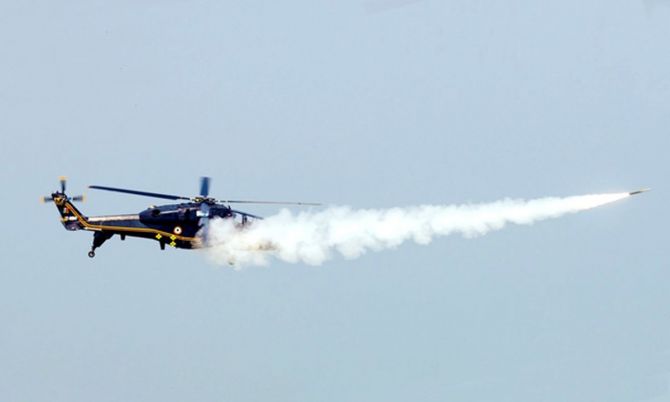
The LCH carried out a couple of landings at the ALG and subsequently landed at Base camp of the Siachen Glacier to refuel.
As they landed, news came in that all hell had broken loose. The talks with the Chinese had broken down with them accusing us of aggressive actions.
"Till date, I do not know how the IAF convinced the army to permit us to land. Maybe one day, I will find that out from my friends who were there over a drink!" says John with a grin.
"We also flew by night in the area, notably to Nyoma and beyond. The flying was done using the NVGs. Flying with the moon casting shadows on one side of the mountain was an eerie and scary feeling, something that we got used to after a few sorties."
"This is probably the first time in aviation history that a platform was deployed operationally even before it was inducted into the armed forces.
"My salutations are in order to the entire team of HAL which worked like military men on a mission in those days at Leh. They were at the aircraft well before sunrise and left for their rooms only late at night after making sure the helicopter was secured and ready for the next day's missions. All missions were successful only because of their untiring efforts."
I asked John to tell me something about the weapon system integrations and the trials.
"Weapon firing trials was a challenge, and it was a tough ask.
"Air to air missile firing was especially interesting. These trials were done right in the middle of a bad weather period in the Bay of Bengal. We were to fire the Air to Air missile on a target drone. This was to be done from hover at a thousand feet above the water surface and this was difficult without any visual reference to keep the aircraft steady over one point.
"There was a precise moment in time and space when the target would be at the correct angle and range for gathering data. Being a 'test' firing, there were multiple conditions to be met and clearances to be obtained from telemetry and range sensors."
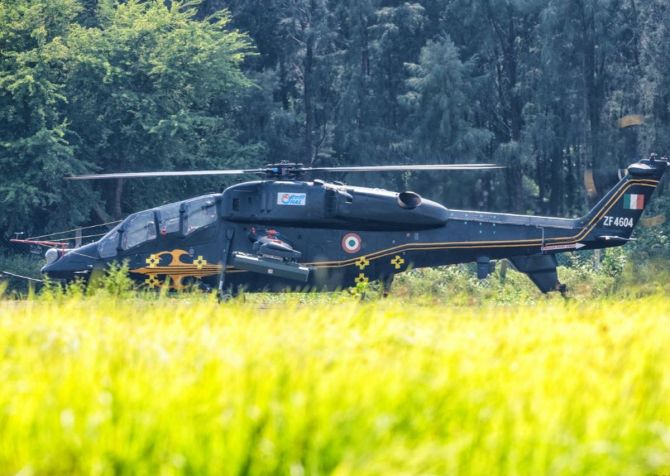
A Mi-17 V5 helicopter was to tag along close to the hovering helicopter and take a video of the entire event.
"This young pilot was briefed to stick to me as close as possible and he did so like a good wingman. I was busy with my mission and had difficulty in keeping my machine stable; I wonder how much trouble I may have caused to the Mi-17, but I noticed that he stuck to me through the sortie -- the young pilot was too good!."
Most firing trials were a race against time. The firing ranges were busy with many other fighters and helicopters using it for their own practice.
"We barely managed slots for firing in this melee, often during lunch hours. We also utilised the time slots between their missions to go and check out our results before the next set of aircraft came overhead to drop their bombs!"
The LCH had to be taken all over the country for various trials. From Chennai to Chandipur; from Jaisalmer to Leh to Jodhpur, curious onlookers gathered around us when they saw this mean looking creature.
"When they were told that it was our own home grown attack helicopter, they would ask for autographs, take photos and touch the machine to feel its smooth finish. Some of the people wanted to know if we carried some pretty air hostesses on board to look after us!
"And when they saw us eating our sandwiches from crumpled brown bags under the shade of the helicopter, they realised how alike them we were!"
In fact, when the mean looking black coloured helicopter was seen flying close to the border during the Galwan crisis, it caused a few alarm bells to ring on our side too.
"Our vigilant men reported seeing 'enemy' attack helicopters on our side of the border!"
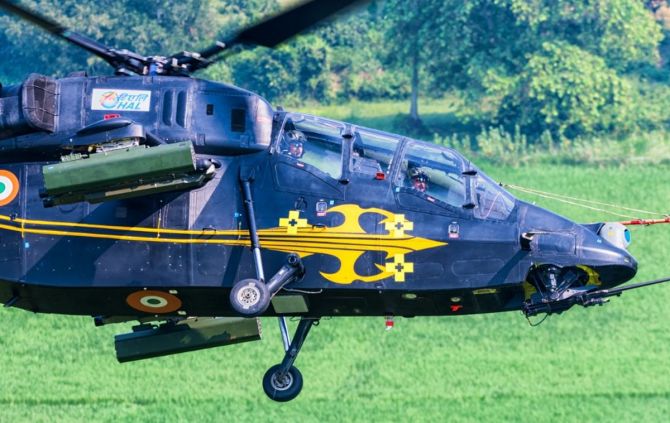
I had the fortune of speaking to an enthusiastic designer and engineer, Mr K G Kumaraswamy, fondly called 'KGK' by all those who worked with him.
"I was part of the LCH journey from the drawing board working alongside Mr Rao and Mr Chalvade; both amazing designers. After Mr Chalvade moved on to another division, I became the Project head from 2011 and continued till my retirement."
"I would like to first clear the myth carried by a large number of people about how the LCH was born. When some people ask if this helicopter is a re-designed and reverse engineered Advanced Light Helicopter, my answer is a vehement NO!
"Yes, we started our journey from that design initially, but as we went along, everything changed. It is not a cut, paste and copy effort as one may like to think. In a design, if one parameter is changed, it results in a 100 more changes in other areas, in areas which may not be connected with the change!"
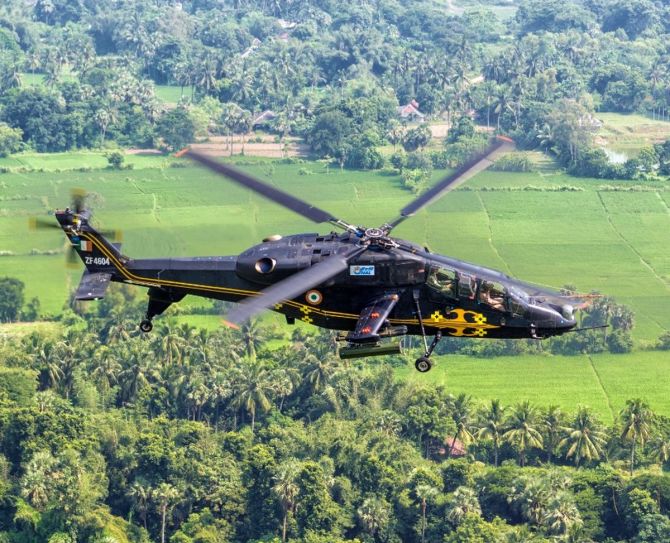
While somethings could be explained mathematically or scientifically, some problems were unique and baffling.
"Take, for instance, the main rotor blades. We fitted the newly designed blades for the ALH and realised that the helicopter was getting into a vertical bounce in flight. And when we put the older version blades on, these vibrations simply vanished!
"The vibrations that Harry spoke about were unique too. We concluded mathematically that we needed to shorten the nose of the helicopter by approximately 200 mm to get rid of them. While the machine was stripped, it was realised that it was possible to shorten the nose by only about 90 mm; anything more than that would mean a complete new design, delaying the programme.
"And while we got rid of the 'bounce', we were pleasantly surprised to find that the set of blades that we had chosen were mating perfectly with the fuselage; thereby giving us better performance!.
"A total of 13 to 15 modifications later, we had a shortened nose section of the aircraft which was promptly flown to Chennai for testing at sea level. We were relieved to find out that the vibrations had ceased and the aircraft continued to fly there for another 50 hours finishing off with other trials too!"
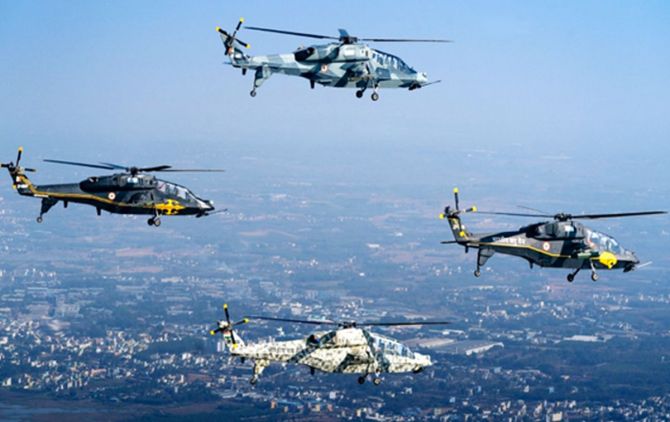
The retired technologist went on to tell me another interesting story.
"In the 'Iron Fist' exercise of 2014 where the IAF aircraft display their shooting prowess, the TD-1 did just some manoeuvring in front of the crowd. The IAF gentry and the politicians had the first glimpse of the black beauty then and were impressed."
The subsequent two years saw weapons integrated with the aircraft and trials were in their last phase.
"In the same exercise in 2016, the IAF requested us to carry out a live firing in front of the prime minister who was the chief guest at the show.
"The helicopter weapon system computers and software hadn't been aligned. We were not confident of firing at that stage. But we were committed to the cause and decided to show how we also could be as flexible and innovative as our defence forces.
"The ALH weapon system with its software was integrated temporarily on the aircraft and Unni Pillai along with John flew the first live demonstration mission in front of a huge crowd of politicians, bureaucrats and military stalwarts.
"I watched with bated breath as the helicopter came in for the attack. The fighter which had come before us had missed the target and I had heard some disappointed 'oohs' and 'aahs' from the crowd.
"I kept my fingers crossed and my eyes on our helicopter waiting for the sound and flash of the rockets as they left the aircraft. Exceptional piloting skills and good luck saved us the day. The rockets were bang on target and a roar from the crowd that erupted as the target was destroyed was like music to the ears!"
The success of the firing instilled confidence in the IAF, HAL and the others in the decision making chain that we had a potent weapon platform in the making.
"Making a flying machine is one thing. Integrating a whole lot of technology onto it to make it into a weapon of war is quite another. I am so happy to have been part of this programme right till the end and am thankful to all those who worked alongside me to make this dream a reality.
"The aircraft was ready for production in 2018 or so. We have had to wait for another 4 years for this machine to be inducted into the services; this long gestation period has meant that I have had to see my dream project fructify as a retired man!"
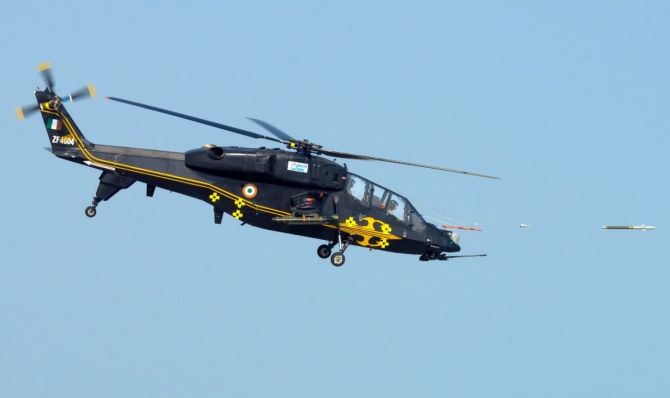
The Light Combat Helicopter's journey has been a long and arduous one so far.
Many scientists, pilots, engineers, thinkers, politicians, economists and more have worked in their little cubby holes going way beyond their call; and under innumerable constraints, helped in the birth of this baby.
Our nation must salute the HAL for adding a feather to their cap and being part of the Atmanirbhar Bharat story.
Presently, the helicopters being handed over to the IAF are capable of strike, air to air firing, anti-tank and anti-armour operations, radar busting, in support of the infantry.
It is left to the IAF and the Indian Army to exploit the machine to its fullest with intensive training and HAL to keep tweaking the systems as we go along in the operational utilisation phase.
All of India welcomes this aircraft into the Armed Forces arsenal and wishes it a safe tenure and happy shooting.
May it rule the skies and ensure that the enemies are given a fitting reply when the need arises.
Air Commodore Nitin Sathe retired from the Indian Air Force in February 2020 after a distinguished 35 year career.
The author of three books, you can read Air Commodore Sathe's earlier articles here.
Feature Presentation: Rajesh Alva/Rediff.com


